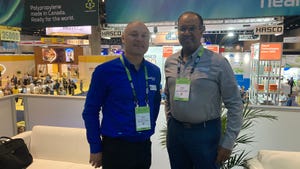FRX Polymers focusing on expanding application of polymeric halogen-free flame retardants at K
October 6, 2016

FRX Polymers, Inc. will focus on its latest polymeric phosphonate halogen-free flame retardant developments and the expanded range of end-use applications at the K 2016 exhibition, which runs Oct. 19-26, in Düsseldorf, Germany. In Hall 5/C06-1, FRX will highlight its highly successful application development work in key markets such as electronics, building and construction, and transportation.
Circuit boards are a major user of phosphonate flame retardants from FRX |
After extensive product development work and the opening of a full-scale commercial manufacturing facility in Antwerp, Belgium, FRX has expanded its global footprint for Nofia flame retardants (FRs) and embarked on an ambitious application development effort. “It’s an exciting time because our enabling technology is successfully being adopted in a wide range of applications for FR polymers,” said Marc-Andre Lebel, President and CEO of FRX Polymers.
FRX Polymers announced a debottlenecking of its Antwerp, Belgium facility in the fourth quarter of 2015 which increased capacity by 30%. Plans are also underway for a major debottlenecking project over the next 12-18 months.
One key advancement is Nofia phosphonate’s suitability in thin-wall applications in film and injection molding. Nofia can deliver both flame retardancy and transparency for a range of applications unlike other competitive non-halogenated additives. In a non-halogenated FR polycarbonate, Nofia copolymer helps to achieve a thin (<1.0 mm), clear V-0 material. Nofia copolymer is currently used in a 0.8-mm-thick window for a valve assembly which is rated UL 94 V-0 and is in testing in a number of transparent applications requiring 0.4 mm V-0. In addition, Nofia phosphonates have high-flow properties, making them ideal for these thin, clear applications.
Nofia is also being used as an FR additive in PET foam for structural panels used in mass transportation and building and construction markets. Nofia reportedly does not disrupt the foaming process and can be successfully applied to virgin and recycled PET.
In highly-filled polycarbonate applications in electronics and transportation applications, Nofia polymers show excellent adhesion to glass and carbon fibers which allows the composite to retain outstanding mechanical properties and deliver excellent FR properties. Higher levels of reinforcements are possible with little to no impact on properties when using Nofia.
Nofia FR has also made strong inroads in copper clad laminates (CCLs) which are used as circuit board substrates in electronics applications. OEMs are leaning toward non-halogenated circuit boards while the performance requirements continue to push the limits of this technology. FRX has worked closely with China’s Shengyi Technology Company to jointly develop a new copper clad laminate (CCL) product, based on FRX Polymers’ Nofia FR hardener system, which delivers an order of magnitude lower dielectric loss (Df) while also increasing the CCL’s modulus and reducing its coefficient of thermal expansion (CTE) compared to current commercial halogen-free systems. In addition, the Nofia system is said to deliver outstanding FR properties, peel strength, and durability. Nofia reactive oligomers achieve this performance because they are used as hardeners and are therefore reacted into the epoxy during the curing process. In addition, they demonstrate good affinity for inorganic additives.
Meanwhile, Nofia oligomers are also being used in unsaturated polyester applications in building and construction and transportation. These oligomers deliver numerous benefits over competing non-halogenated FR additives which have limited use due to the plasticizing effect on the thermoset system that affects surface hardness and curing. Nofia oligomers are being successfully formulated in both transparent and opaque applications where aesthetics and weight reduction are key performance requirements.
Nofia phosphonates replace halogenated flame retardants, some of which are being phased out due to toxicity concerns. Nofia phosphonates are produced using sustainable green chemistry principles such as a solvent-free production process, no waste by-products, and near 100% “atom efficiency.
You May Also Like


